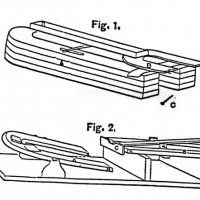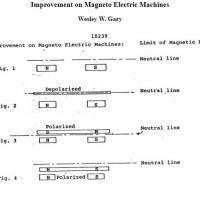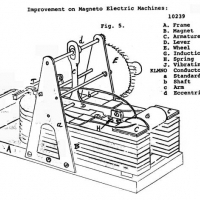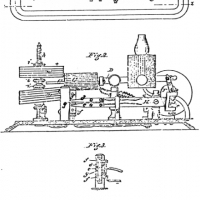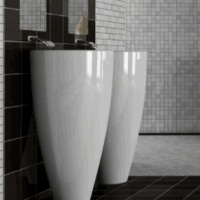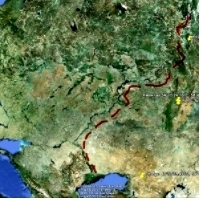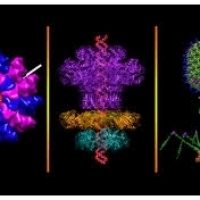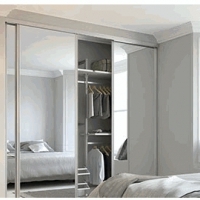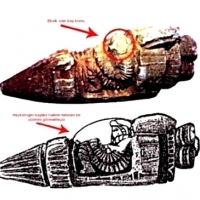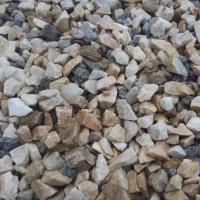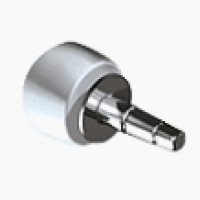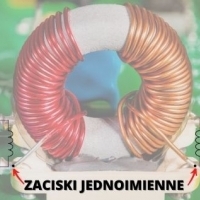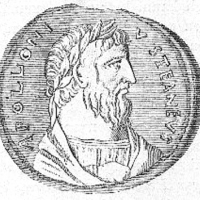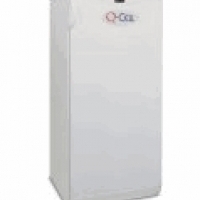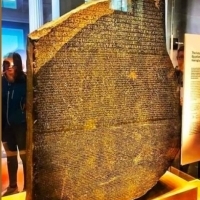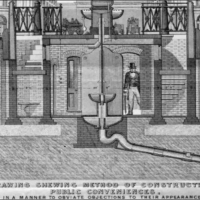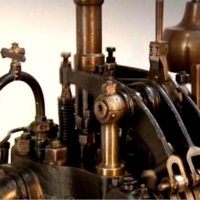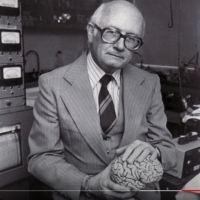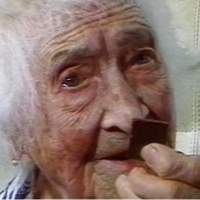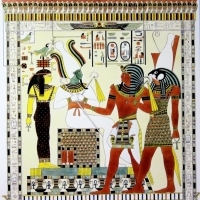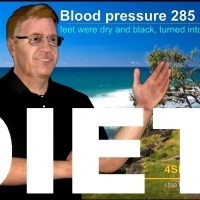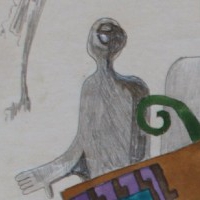0 : Odsłon:
With an ordinary horseshoe magnet, a bit of soft iron, and a common shingle-nail, a practical inventor, who for years has been pondering over the power lying dormant in the magnet, now demonstrates as his discovery a fact of the utmost importance in magnetic science, which has hitherto escaped the observation of both scientists and practical electricians, namely, the existence of a neutral line in the magnetic field --- a line where the polarity of an induced magnet ceases, and beyond which it changes. With equally simple appliances he shows the practical utilization of his discovery in such a way as to produce a magnetic motor, thus opening up a bewildering prospect of the possibilities before us in revolutionizing the present methods of motive power through the substitution of a wonderfully cheap and safe agent. By his achievement Mr. Wesley W. Gary has quite upset the theories of magnetic philosophy hitherto prevailing, and lifted magnetism out from among the static forces where science has placed it, to the position of a dynamic power. The Gary Magnetic Motor, the result of Mr. Gary's long years of study, in a word, a simple contrivance which furnishes its own power, and will run until worn out by the force of friction, coming dangerously near to that awful bugbear, perpetual motion.
The old way of looking at magnetism has been to regard it as a force like that of gravity, the expenditure of an amount of energy equal to its attraction being required to overcome it; consequently its power could not be availed of. Accepting this theory, it would be as idle to attempt to make use of the permanent magnet as a motive power as to try to lift oneself by one's bootstraps. But Mr. Gary, ignoring theories, toiled away at his experiments with extraordinary patience and perseverance, and at last made the discovery which seems to necessitate reconstruction of the accepted philosophy. To understand the operation of the Gary Magnetic Motor, it is necessary first to comprehend thoroughly the principle underlying it --- the existence of the neutral line and the change in polarity, which Mr. Gary demonstrates by his horseshoe magnet, his bit of soft iron, and his common shingle-nail. This is illustrated in Figure 1. The latter A represents a compound magnet; B, a piece of soft iron made fast to a lever with a pivoted joint in the center, the iron becoming a magnet by induction when in the magnetic field of the permanent magnet; C, a small nail that drops off when the iron, or induced magnet, is on the neutral line. By pressing the finger on the lever at D the iron is raised above the neutral line. Now let the nail be applied to the end of the induced magnet at E; it clings to it, and the point is turned inward toward the pole of the magnet directly below it, thus indicating that the induced magnet is of opposite polarity from the permanent one. Now let the iron be gradually lowered toward the magnet; the nail drops off at the neutral line, and now its point is turned outward, or away from the magnetic pole below. In this way Mr. Gary proves that the polarity of an induced magnet is changed by passing over the neutral line without coming into contact. In the experiment strips of paper are placed under the soft iron, or induced magnet, as shown in the figure, to prevent contact.
The neutral line is shown to extend completely around the magnet; and a piece of soft iron placed on this line will entirely cut off the attraction of the magnet from anything beyond. The action of this cutting off is illustrated in Figure 2. The letters A and B represent the one a balanced magnet and the other a stationary magnet. The magnet A is balanced on a joint, and the two magnets are placed with opposite poles facing each other. The letter C is a piece of thin or sheet iron, as the case may be, made fast to a lever with a joint in the center, and so adjusted that the iron will move on the neutral line in front of the poles of the stationary magnet. By pressing the finger on the lever at D the iron is raised, thus withdrawing the cut-off so that the magnet A is attracted and drawn upward by the magnet B. Remove the finger, and the cut-off drops between the poles, and in consequence, the magnet A drops again. The same movement of magnets can be obtained by placing a piece of iron across the poles of the magnet B after the magnet A has been drawn near to it. The magnet A will thereupon immediately fall away; but the iron can only be balanced, and the balance not disturbed, by the action of the magnets upon each other when the iron is on the neutral line, and does not move nearer or father away from the magnet B.
It may not be found easy to demonstrate these principles at the first trials. But it should be borne in mind that it took the inventor himself four years after he had discovered the principle to adjust the delicate balance so as to get a machine which would go. Now, however, that he has thought out the entire problem, and frankly tells the world how he has solved it, any person at all skillful and patient, and with a little knowledge of mechanics, may soon succeed in demonstrating it for himself.
The principle underlying the motor and the method by which a motion is obtained now being explained, let us examine the inventor's working models. The beam movement is the simplest, and by it, it is claimed, the most power can be obtained from the magnets. This is illustrated in Figure 3. The letter A represents a stationary magnet, and B the soft iron, or induced magnet, fastened to a lever with a joint in the center, and so balanced that the stationary magnet will not quite draw it over the neutral line. The letter C represents a beam constructed of a double magnet, clamped together in the center and balanced on a joint. One end is set opposite the stationary magnet, with like poles separating each other. The beam is so balanced that when the soft iron B on the magnet A is below the neutral line, it (the beam) is repelled down to the lower dotted line indicated by the letter D. The beam strikes the lever E with the pin F attached, and drives it (the lever) against the pin G, which is attached to the soft iron B, which is thus driven above the neutral line, where its polarity changes. The soft iron now attracts the beam magnet C to the upper dotted line, whereupon it (the soft iron) is again drawn down over the neutral line, and its polarity again changing, the beam magnet C is again repelled to the lower line, continuing so to move until it is stopped or worn out. This simply illustrates the beam movement. To gain a large amount of power the inventor would place groups of compound stationary magnets above and below the beam at each side, and the soft iron magnets, in this case four in number, connected by rods passing down between the poles of the stationary magnets. A "Pitman" connecting the beam with a flywheel to change the reciprocating into a rotary motion would be the means of transmitting the power. With magnets of great size an enormous power, he claims, could be obtained in this way.
One of the daintiest and prettiest of Mr. Gary's models is that illustrating the action of a rotary motor. There is a peculiar fascination in watching the action of this neat little contrivance. It is shown in Figure 4. The letter A represents an upright magnet hung on a perpendicular shaft; B, the horizontal magnets; C, the soft iron which is fastened to the lever D; E, the pivoted joint on which the lever is balanced; and F, the thumb-screw for adjusting the movement of the soft iron. This soft iron is so balanced that as the north pole of the upright magnet A swings around opposite and above the south pole of the horizontal magnets B, it drops below the neutral line and changes its polarity. As the magnet A turns around until its north pole is opposite and above the north pole of the magnets B, the soft iron is drawn upward and over the neutral line, so that its polarity is changed again. At this point the polarity in the soft iron C is like that of the permanent magnets A and B. To start the engine the magnet A is turned around to the last-named position, the poles opposite like poles of the magnet B; then one pole of the magnet A is pushed a little forward and over the soft iron. This rotary magnet is repelled by the magnets B, and also by the soft iron; it turns around until the unlike poles of the permanent magnets become opposite; as they attract each other the soft iron drops below the neutral line, the polarity changes and becomes opposite to that of the magnets B and like that of the magnet A; the momentum gained carries the pole of A a little forward of B and over the soft iron, which, now being of like polarity, repels it around to the starting point, completing the revolution. The magnets A and B now compound or unite their forces, and the soft iron is again drawn up over the neutral line; its polarity is changed, and another revolution is made without any other force applied than the force of the magnets. The motion will continue until some outside force is applied to stop it, or until the machine is worn out.
The result is the same as would be obtained were the magnets B removed and the soft iron coiled with wire, and battery force applied sufficient to give it the same power that it gets from the magnets B, and a current-changer applied to change the polarity. The power required to work the current-changer in this case would be in excess of the power demanded to move the soft iron over the neutral line, since no power is required from the revolving magnet under these circumstances, it being moved by the magnets compounding when like poles are opposite each other, three magnets thus attracting the iron. When opposite poles are near together, they attract each other and let the iron drop below the line. The soft iron, with its lever, is finely balanced at the joint, and has small springs applied and adjusted so as to balance it against the power of the magnets. In this working model the soft iron vibrates less than a fiftieth of an inch.
This rotary motion is intended for use in small engines where light power is required, such as propelling sewing machines, for dental work, show windows, etc.
When Wesley Gary was a boy of nine years, the electric telegraph was in its infancy and the marvel of the day; and his father, who was a clergyman in Cortland County, New York, used to take up matters of general interest and make them the subject of an occasional lecture, among other things, giving much attention to the explanation of this new invention. To illustrate his remarks on the subject he employed an electromagnetic machine. This and his father's talk naturally excited the boy's curiosity, and he used to ponder much on the relations of electricity and magnetism, until he formed a shadowy idea that somehow they must become a great power in the world. He never lost his interest in the subject, though his rude experiments were interrupted for a while by the work of his young manhood. When the choice of a calling was demanded, he at first had a vague feeling that he would like to be an artist. "But", he says, "my friends would have thought that almost as useless and unpractical as to seek for perpetual motion." At last he went into the woods a-lumbering, and took contracts to clear large tracts of woodland in Western and Central New York, floating the timber down the canals to Troy. He followed this business for several years, when he was forced to abandon it by a serious attack of inflammatory rheumatism, brought about through exposure in the woods. And this, unfortunate as it must have seemed at the time, proved the turning-point in his life. His family physicians insisted that he must look for some other means of livelihood than lumbering. To the query, "What shall I do?" it was suggested that he might take to preaching, following in the footsteps of his father, and of a brother who had adopted the profession. But this he said he could never do; he would do his best to practice, but he couldn't preach. "Invent something, then," said the doctor. "There is no doubt in my mind that you were meant for an inventor." This was said in all seriousness, and Mr. Gary was at length persuaded that the doctor knew him better than he did himself. His thoughts naturally recurring to the experiments and dreams of his youth, he determined to devote all his energies to the problem. He felt more and more confident, as he dwelt on the matter, that a great force lay imprisoned within the magnet; that some time it must be unlocked and set to doing the world's work; that the key was hidden somewhere, and that he might find it as well as some one else.
At Huntington, Pennsylvania, Mr. Gary made his first practical demonstration, and allowed his discovery to be examined and the fact published. He has long been satisfied, from his experiments, that if he could devise a "cut-off", the means of neutralizing the attractive power of a stationary magnet on another raised above it and adjusted on a pivot, unlike poles opposite, and so arrange this cut-off as to work automatically, he could produce motion in a balanced magnet. To this end he persistently experimented, and it was only about four years ago that he made the discovery, the key to his problem, which is the basis of his present motor, and upsets our philosophy. In experimenting one day with a piece of soft iron upon a magnet he made the discovery of the neutral line and the change of polarity. At first he gave little attention to the discovery of the change of polarity, not then recognizing its significance, being absorbed entirely by the possibilities the discovery of the neutral line opened up to him. Here was the point for his cut-off. For a while he experimented entirely with batteries, but in September, 1874, he succeeded in obtaining a movement independent of the battery. This was done on the principle illustrated in Figure 2. The balanced magnet, with opposite poles to the stationary magnet, was weighted so that the poles would fall down when not attracted by the stationary magnet. When it was attracted up to the stationary magnet, a spring was touched by the movement, and thus the lever with the soft iron was made to descend between the two magnets on the neutral line, and so cutting of the mutual attraction. Then the balanced magnet, responding to the force of gravitation, descended, and, when down, struck another spring, by means of which the cut-off was lifted back to its original position, and consequently the force of attraction between the magnets was again brought into play. In June, the following year, Mr. Gary exhibited this continuous movement to a number of gentlemen, protecting himself by covering the cut-of with copper, so as to disguise the real material used, and prevent anyone from robbing him of his discovery. The publication in the local newspaper of the performance of the little machine, which was copied far and wide, excited much interest. But the inventor was by no means satisfied. He had succeeded in securing a continuous motion, but not in a practical motor. He had invented a unique plaything, but not a machine that would do a man's work. So he made further experiments in one direction and another, using for a long time the battery; and it was not until some time after he moved to Boston (which was about two years ago) that he was convinced that the point in the change of polarity, with which he was so little impressed when he first hit upon them along with his discovery of the neutral line, were the true ones to work upon. Thereafter his progress was most rapid, and in a little while he had constructed working models, not only to his own satisfaction, but to that of those experts who had the fairness to give them a critical and thorough examination, clearly demonstrating his ability to secure motion and power, as they had never before been secured, from self-feeding and self-acting machines. His claim, as he formally puts it, is this: "I have discovered that a straight piece of iron placed across the poles of a magnet, and near to their end, changes its polarity while in the magnetic field and before it comes in contact with the magnet, the fact being, however, that actual contact is guarded against. The conditions are that the thickness of the iron magnet must be proportioned to the power of the magnet, and that the neutral line, or line of change in the polarity of the iron, is nearer or more distant from the magnet according to the power of the latter and the thickness of the former. My whole discovery is based upon this change of polarity in the iron, with or without a battery." Power can be increased to any extent, or diminished, by the addition or withdrawal of magnets.
Mr. Gary is 41 years old, having been born in 1837. During the years devoted to working out his problem he has supported himself by the proceeds from the sale of a few useful inventions made from time to time when he was forced to turn aside from his experiments to raise funds. From the sale of one of these inventions --- a simple little thing --- he realized something like $10,000.
The announcement of the invention of the magnetic motor came at a moment when the electric light excitement was at its height. The holders of gas stocks were in a state of anxiety, and those who had given attention to the study of the principle of the new light expressed the belief that it was only the question of the cost of power used to generate the electricity for the light that stood in the way of its general introduction and substitution for gas. A prominent electrician, who was one day examining Mr. Gary's principle, asked if in the change of polarity he had obtained electric sparks. He said that he had, and the former then suggested that the principle be used in the construction of a magneto-electric machine, and that it might turn out to be superior to anything then in use. Acting on this suggestion, Mr. Gary set to work, and within a week had perfected a machine which apparently proved a marvel of efficiency and simplicity. In all previous machines electricity is generated by revolving a piece of soft iron in front of the poles of a permanent magnet. But to do this at a rate of speed high enough to produce sparks in such rapid succession as to keep up a steady current of electricity suitable for the light, considerable power is required. In Mr. Gary's machine, however, the piece of soft iron, or armature, coiled with wire, has only to be moved across the neutral line to secure the same result. Every time the polarity changes, a spark is produced. The slightest vibration is enough to secure this, and with each vibration two sparks are produced, just as with each revolution in the other method. An enormous volume can be secured with an expenditure of force so diminutive that a caged squirrel might furnish it. With the employment of one of the smallest of the magnetic motors, power may be supplied and electricity generated at no expense beyond the cost of the machine.
The announcement of the invention of the magnetic motor was naturally received with incredulity, although the recent achievements in mechanical science had prepared the public for almost anything, and it could not be very much astonished at whatever might come next. Some admitted that there might be something in it; others shrugged their shoulders and said, "Wait and see', while the scientific referred all questioners to the laws of magnetic science; and believers in book authority responded, "It can't be so, because the law says it can't." A few scientists, however, came forward, curious to see, and examined Mr. Gary's models; and when reports went out of the conversion of two or three of the most eminent among them, interest generally was awakened, and professors from Harvard and the Massachusetts Institute of Technology called, examined, and were impressed. More promptly than the scientists, capitalists moved; and before science had openly acknowledged the discovery and the principle of the invention, men of money were after Mr. Gary for the right to use the motor for various purposes: one wished to use it for clocks, another for sewing machines, others for dental engines, and so on.
It is as yet too soon to speculate upon what may result from the discovery; but since it produces power in two ways, both directly by magnets and indirectly by the generation of unlimited electricity, it would seem that it really might become available in time for all purposes to which electricity might long ago have been devoted except for the great expense involved. Within one year after the invention of the telephone it was in practical use all over the world, from the United States to Japan. And it is not incredible that in 1880 one may be holding a magnetic motor in his pocket, running the watch which requires no winding up, and, seated in a railway car, be whirling across the continent behind a locomotive impelled by the same agency.
Canadian Patent #10239
(July 16, 1879)
Improvement on Magneto Electric Machines:
Wesley W. Gary.
The primary object of my invention is to facilitate and greatly lessen the expense of generating or developing electrical currents by dynamo machines, and instruments, by so improving their construction and modes of action that they may be operated by a very small amount of power and at high rates of speed.
With this end in view, the invention consists broadly, in so constructing the machine or instrument that the soft iron armature or core used with the induction coil, is operated constantly in one and the same magnetic field, and caused to be polarized and depolarized or to change its polarity without departing from such field.
Many machines have been hitherto constructed for the purpose of developing electrical currents, through the medium of a soft iron armature coiled with wire and subjected to and magnetized by the inductive influence of a permanent magnet, the armature or the magnet being moved, one in relation to the other, in such manner as to cause the armature to change or lose its polarity rapidly and at frequent intervals.
In order to secure this reversal or loss of polarity in the armature without having it actually touch the magnet it has been hitherto considered necessary that the armature should be carried into and out of the magnetic field or field of attraction of the magnet; or else from the field of one pole into that of the other. This operation required the movement of the armature a long distance, necessitating the expenditure of a large amount of power, limited the frequency of the polar changes, and precluded the full utilization of the magnetic influence.
My invention derives its value mainly from the fact that I do not carry the armature out of the magnetic field, but operate it wholly therein, and secure by a very slight movement the same or better results than those secured in existing machines.
My invention is based upon the fact hitherto unknown, that there exists in the magnetic field or field of attraction of every magnet, at a greater or less distance from the magnet, what I term a neutral line at which soft iron will not be polarized, or magnetized, by the inductive action of the magnet.
The location of the neutral line as regards its distance from the magnet differs in different cases, the line approaching the magnet in proportion to the increase in strength of the magnet and receding as the size or cubic contents of the armature is increased.
The location of the line may be readily determined by applying a coil and galvanometer to the iron and moving it to and from the magnet; or by applying a dipping needle to the armature and noting the point at which the needle assumes a horizontal position or by allowing a tack or other small piece of iron to adhere to the armature and noting the point at which the tack is released by the same.
I have discovered that iron placed on this line although subject to a strong attractive influence on the part of the magnet, remains unpolarized, but that upon moving it from the line in either direction it instantly assumes a polarity. I have also discovered that the polarity of the iron differs on opposite sides of the line and changes on crossing the same, so that if the iron placed in close proximity to the magnet and polarized, by induction, be carried outward, it will lose polarity on reaching the neutral line, and then assume a reverse polarity as it passes from the line outward.
By availing myself of this fact and arranging the armature to vibrate from the neutral line inward, or from the neutral line outward, or to work across the line, and in connection with a commutator, I secure the required changes in the polarity of the armature and produce the same results by a very short movement that are now secured by the longer one.
In constructing machines and instruments on my plan, the details may be constructed and arranged in any manner desired provided the armature has the above described action in relation to the magnet.
The best results are secured by using a horse-shoe magnet, compound if desired, extending the armature across its two poles on one side, and then arranging the armature to move only between the neutral line and the magnet.
In the accompanying drawings, Figs. 1, 2, 3, and 4, represent the relation of the neutral line to the magnet and magnetic field, and also the depolarization and change of polarity of the armature.
Figure 5 represents a perspective view of one form of magneto-electric machine constructed on my plan.
Referring to the drawings, A, represents a base frame provided with uprights, a, and sustaining in a fixed position a horizontal permanent magnet B, of the ordinary compound horse-shoe type. C, represents a flat horizontal armature of soft iron lying above and extending across both poles of the magnet and secured rigidly to one end of a horizontal vibrating lever D, which is sustained by a transverse shaft b, mounted in the standards a. This lever is provided with an upright arm c, the upper end of which is slotted to receive and is vibrated by an eccentric, d, mounted on a shaft, c, the end of which is provided with a small pinion f, and driven at a high speed by a large gear wheel E, as shown. This arrangement causes the rotation of wheel E to vibrate the lever and move the armature to and from the magnet with great rapidity. Around the armature, which is preferably reduced and rounded at the middle, there is wound an ordinary wire induction coil G.
In order to balance or sustain the armature against the attractive influence of the magnet and avoid the necessity of employing a driving power sufficient to overcome the same, I place below the vibrating lever two or more springs H, of different heights, arranged to come into action successively against the under side of the lever and offer an increasing resistance as the armature approaches the magnet-and becomes subject to an increasing attraction.
Under this arrangement it is only necessary, in order to vibrate the armature, to apply a very slight amount of power, an amount sufficient to overcome the friction and the inertia of the moving parts.
In adjusting the machine it is preferred to vibrate the armature, from the neutral line, the position shown in Fig. 2, inward toward the magnet, to the position shown, in Figure 4, in which case the armature will be polarized as it leaves the line and depolarized as it again reaches the line. Owing to the fact that the armature requires a very slight movement, in some cases not exceeding the fiftieth part of an inch; and the fact that it is balanced or sustained against the attractive influence of the magnet, I am able to drive the machine at a very high speed by the application of very little power; and owing to the fact that the armature is operated only in close proximity to the magnet where the attraction and inductive action are very powerful, I produce in the wire induced currents of great quantity and intensity.
If for any special reason it may be considered desirable so to do, the parts may be adjusted to vibrate the armature from the neutral line outward without passing beyond the magnetic field. Or if desired, the parts may so adjusted that the armature shall vibrate to and from the magnet across the neutral line, without passing from the magnetic field. In such case there will be two direct currents or impulses induced during the outward, and two during the inward movement or the armature.
For the purpose of producing a continuous current, a commutator or current changer of any suitable or ordinary construction may be used. This commutator may be actuated in any suitable manner, one simple arrangement being shown in the drawing, in which the rear end of the lever is arranged to vibrate an arm, J, the end of which is provided with two conducting fingers, K and L, to which the ends of the coil are connected. The fingers play across three metal plates, M, N and O, which are connected, the first two with the conductor P, and the other with conductor O, as shown, the arrangement being such that the course of the current is changed as the current in the coil reverses, so as to produce a continuous current in the conductors P and O. It is to be noted that in all cases the construction of the machine is to be such as to utilize the depolarization of the armature at the neutral line; that the armature is to remain within the magnetic field; and that it is unnecessary to move the armature through the entire field. The arrangement of the vibrating armature across both poles of the magnet as shown, enables me to make constant use of both poles and the entire armature, thus utilizing the full power and effect of the magnet. The best results are secured when the armature consists as shown in the drawing, of two plates or pieces riveted together.
As before stated, the form, construction, and arrangement of the parts may be modified as desired, provided the armature operates within the magnetic field, and provided also, the current produced by the depolarization of the armature at the neutral line is made available for use.
Having thus described my invention what I claim is:
The herein described method of producing induced electrical currents, consisting in vibrating an iron armature coiled with wire, to and from the neutral line in the field of a permanent magnet.
In a magneto-electric machine or instrument, the combination of a permanent magnet, an induction coil, and a soft iron armature arranged to move wholly within the magnetic field, to and from the neutral line.
In a magneto-electric machine, the combination of a permanent magnet, an induction coil, and an armature, and operating mechanism arranged to vibrate the armature to and from the magnet, from or across the neutral line, without departing from the magnetic field.
The combination in a magneto-electric machine, of a permanent magnet, an induction coil, and a soft iron armature vibrated only from the neutral line toward the magnet and back to the neutral line.
In a magneto-electric machine, the combination of a permanent magnet, an induction coil, and a soft iron armature arranged to vibrate to and from and to stop upon the neutral line in the magnetic field.
The combination in a magneto-electric machine of permanent magnet, an induction coil, an iron armature vibrating wholly within the magnetic field, to or across the neutral line, and an automatic commutator arranged to change the course of the induced current when the armature is upon the neutral line.
In a magneto-electric machine, the combination of a permanent magnet, an induction coil and armature, and an automatic commutator or current changer arranged to move as the armature reaches the neutral line in the magnetic field.
In a magneto-electric machine, the combination of a permanent magnet, an armature moving to and from the same and a spring or its equivalent arranged to counteract the attractive influence of the magnet.
The combination in a magneto-electric machine of a permanent magnet, an armature arranged to move to and from the magnet, and springs or equivalent devices, arranged to offer an increasing resistance to the armature as it approaches the magnet.
The combination of the permanent magnet, the induction coil, and the armature extending across both poles of the magnet, and arranged to move to or from them both at the same time.
The combination of the permanent magnet, the armature extending across both poles of the magnet, the induction coil, the vibrating lever, and the eccentric arranged, to vibrate the lever as shown.
Wesley Ward Gary
Washington DC
February 27, 1879
Canadian Patent 190,206
(May 1, 1877)
Wesley W. Gary
Improvement in Electromagnetic Motors
To all whom it may concern:
Be it known that I, Wesley W. Gary, of Huntington, in the county of Huntington and State of Pennsylvania, have invented certain Improvements in Electric Motors, of which the following is a specification.
My invention consists in the use of a reciprocating electromagnet, the poles of which are changed at each movement, between two permanent magnets arranged with their reverse poles opposite each other; in a peculiar arrangement of devices for reversing the current, and in other details hereinafter describe.
The object of my invention is to apply and fully utilize, in an electric motor, the power of permanent magnets, and to develop from them the greater part of the power, so that motors of great power may be actuated by means of small electromagnets, and a correspondingly small expenditure of battery power. This end I attain by arranging two permanent magnets at a short distance apart, with the negative pole of each opposite the positive pole of the other, and then arranging between them an electromagnet attached to the driving mechanism, and connected with an automatic pole changing device, so that the electromagnet is attracted and repelled by the two permanent magnets alternately, one attracting it at the same time that it is repelled by the other. In this way I am enabled to employ constantly and directly the full power of the electromagnet and both permanent magnets. As it makes no difference in the power o the motor whether the force to move the vibrating magnet emanates from permanent or the electromagnet, it is obvious that the same results may be obtained by the use of strong permanent magnets in connection with a weak electromagnet as are obtained by the use of weak permanent magnets and a strong electromagnet, so that on my plan I am enabled to construct motors of large size and power, and operate them with small batteries at a trifling cost. By increasing the power of the permanent magnets the power of the motor may be increased to any extent required without increasing the amount of battery power required, thus producing a large motor, which may be operated with the same battery power as a small one. In practice, however, it will be found best to increase the size and power of the electromagnet and its battery in proportion to the increased power of the permanent magnets, but the most satisfactory and economical results are obtained when the strength or power of the permanent magnets exceeds that of the electromagnet many times.
The form and position of the electromagnet and the fixed magnets, the construction of the current-changing device, the arrangement of devices for transmitting the power and motion from the vibrating electromagnet, and the other details may be varied at will, as they form no essential or important part of the invention.
It is preferred to employ horseshoe magnets, and to arrange them in parallel planes; but they may be made in other forms, and arranged in different relative positions. The permanent magnets may each be made in a single solid piece, or of a series of thin magnets clamped together, the latter being preferred.
In the accompanying drawings, Figure 1 represents a top plan view of one form of my motor; Figure 2, a side elevation of the same; Figure 3, a detail view, illustrating the construction of the current changer.
A and B represent two horizontal permanent magnets, arranged one above the other, a small distance apart, with the positive pole of each opposite the negative pole of the other. C represents an electromagnet, secured to one end of a pivoted vibrating beam, D, which has its opposite end connected by a pitman, E, to a crank pin on a wheel, F, which is mounted on a main driving-shaft, G, as shown, so that the vibration of the magnet and beam will set the shaft in motion. The ends of the electromagnet C are flattened and extended between the permanent magnets A and B, and the parts so arranged that it is free to vibrate and carry the end of beam D up and down.
The magnet C is connected with a battery of any suitable kind; but between the magnet and the battery there is interposed a current charger, H, which reverses the current of electricity and changes the polarity of the magnet at the end of each vibration of movement, in consequence of which the magnet C is alternately repelled by the magnet A and attracted by magnet B, and then attracted by A and repelled by B, so that it is kept constantly moving up and down between them. The vibration of the electromagnet operates the beam D, which, in turn, through the pitman and crank, operates the shaft on which the wheel is mounted.
The current changer consists of a pivoted vibrating arm, H, having one end forked and operated by a tappet, c, attached to the beam D, and the other end provided with two spring conducting fingers, d and e, which are connected with opposite ends of the helix, and arranged to play over three metal plates, f, f, and g, the two former connected with the negative and the latter with the positive pole of the battery. The fingers always connect with the opposite poles of the battery, and each finger alternates from the positive to a negative plate, in such manner that the current of electricity has its course through the helix of the electromagnet reversed at each movement of the fingers.
In order that the permanent magnets may be adjusted in case of necessity, and that, when they are composed o a series of thin plates or magnets, plates may be added to or removed from the series in order to vary the strength of the magnets, they are mounted on vertical screws h, and secured by the nuts i, in the manner shown.
In practice I find that, in order to prevent the permanent magnets from affecting and partially neutralizing each other, the faces or poles of the electromagnet should be made as wide or wider than those of the permanent magnets.
It is also important that the poles of the electromagnet shall be flattened on the sides, in order that the entire faces may approach close to the faces or poles of the fixed magnets, which should be flattened in like manner.
I am aware that motors consisting of an outside circular series of permanent magnets and a central rotating series of electromagnets, the polarity of which is changed as they pass the others, is old; but my arrangement differs therefrom, and is superior thereto, in this, that I apply the power to move the magnet directly in the line or path o movement, while in the rotary machines, the power is applied at a tangent, and consequently at a great disadvantage.
I am aware that it is old to arrange a vibrating armature between two electromagnets which were either polarized alternately, or else their polarity reversed at each movement of the armature; but they differ in my engine, in that they derive their power wholly from the electromagnets, while in my engine the power is derived mainly from the permanent magnets, and also in that they require the use of two electromagnets, while in my engine one only is used.
My combination possesses the advantages of requiring but little battery power in proportion to the amount of power developed by the engine, and of permitting the vibrating parts to be made light, so that the engine may be operated with rapidity.
It is obvious that, instead of having a single electromagnet and one pair of permanent magnets at one end of the beam, there may be a similar combination used at each end or two or more combinations used at either end. It is also obvious that, instead of using the electromagnet of the horseshoe form, a straight one may be arranged transversely between the two permanent magnets.
Having thus described my invention, what I claim is:
1) The combination, in an electric motor, of two permanent magnets, A and B, and an electromagnet, C, connected with a pole-changing device, and arranged to vibrate between the permanent magnets, substantially as shown and described.
2) The combination of two permanent magnets, arranged with their reverse poles opposite to, but separated from, each other, and a reciprocating electromagnet connected with an automatic pole-changing device, substantially as described.
3) The combination, in an electric motor, of a reciprocating electromagnet, connected with an automatic pole-changing device, and two compound permanent magnets, arranged on opposite sides of the electromagnet, each consisting of a series of thin magnets, mounted in such a manner that the series may be increased or diminished at will, for the purpose of increasing or diminishing the power of the motor.
4) In combination with the magnets A and B and the vibrating electromagnet C, the beam D, provided with the tappet c, and the arm, provide with the fingers d and e, moving upon the plates f, f, and g, as shown.
Polska wersja:
Ulepszenia w Magneto Electric Machines:
: Wyślij Wiadomość.
Przetłumacz ten tekst na 91 języków
: Podobne ogłoszenia.
LINEA. Firma. Dozowniki do mydła. Dozowniki łokciowe. Suszarki do rąk i włosów.
WIELOLETNIA TRADYCJA Linea Trade ma swoją siedzibę w miejscowości Zabrze na ulicy Wolności 68. Linea Trade zaopatruje w swoje produkty takie miejsca jak hotele, restauracje, szpitale czy też szkoły. Od wielu lat zajmuje się dystrybucją dozowników,…
4433AVA. HYDRO LASER. Nakts krēms. atjaunojot ar ilgstošu darbību. Nachtcreme. regeneriert mit längerer Wirkung.
HYDRO LASER. Nakts krēms. atjaunojot ar ilgstošu darbību. Kataloga kods / indekss: 4433AVA. Kategorija: Kosmētika, Hydro Laser liktenis sejas krēmi nakts laikā Kosmētikas veids krēmi darbība hidratācija, atjaunošanās, atjaunošana Jauda 50 ml / 1,7 fl.…
To jest Wielki Mur Transwołga, o którym historycy w ogóle nie mówią.
Uważa się, że Wielki Mur Chiński został zbudowany przez Chińczyków (Arim).Długość tego muru to 9000 km. A teraz patrzymy na mapę ze zdjęcia 1 i kolejne zdjęcia. To jest Wielki Mur Transwołga, o którym historycy w ogóle nie mówią. Ale to jest ten sam cud…
Måder til influenzainfektion og komplikationer: Hvordan man kan forsvare sig mod vira:
Måder til influenzainfektion og komplikationer: Hvordan man kan forsvare sig mod vira: Selve influenzaviruset er opdelt i tre typer, A, B og C, hvoraf mennesket hovedsageligt er inficeret med varianter A og B. Den mest almindelige type A afhænger af…
SCREWFIX. Company. Sliding wardrobe doors and interiors.
Screwfix have partnered with Spaceslide to bring you ScrewfixWardrobes.com Long established specialists in made-to-measure sliding wardrobe doors, and wardrobe storage solutions, ScrewfixWardrobes.com offer a wide range of colours and finishes, all…
Ni ifọwọsi ti o ni ilera ati aṣọ ti ara fun awọn ọmọde.
Ni ifọwọsi ti o ni ilera ati aṣọ ti ara fun awọn ọmọde. Ọdun akọkọ ti igbesi aye ọmọ kan jẹ akoko ayọ ati igbagbogbo inawo, nitori gigun ara ọmọ ti ara ẹni pọ si to 25 cm, i.e. titobi mẹrin. Awọ ẹlẹgẹ ti awọn ọmọde nilo itọju nla, nitorinaa o yẹ ki o…
W tym posążku, który, jak się uważa, pochodzi z Urartian, znajduje się zagubiony astronauta w rakiecie kosmicznej.
W tym posążku, który, jak się uważa, pochodzi z Urartian, znajduje się zagubiony astronauta w rakiecie kosmicznej. Posąg o wielkości 22 cm został wykopany w Toprakkale, znanym w starożytności jako Tuspa . Po odnalezieniu posążek przekazano do do Stanbul…
Według etiopskiego eposu Kebra Nagast, król Salomon miał latającą maszynę, która mogła pokonywać duże odległości w bardzo krótkim czasie.
Według etiopskiego eposu Kebra Nagast, król Salomon miał latającą maszynę, która mogła pokonywać duże odległości w bardzo krótkim czasie. Według archeologa Nicholasa Roericha, Azja Środkowa miała legendy, które mówiły o królu Salomonie lecącym do Tybetu…
Modi di infezione da influenza e complicanze: Come difendersi dai virus:
Modi di infezione da influenza e complicanze: Come difendersi dai virus: Il virus dell'influenza stesso è diviso in tre tipi, A, B e C, di cui l'uomo è infettato principalmente con le varianti A e B. Il tipo più comune A, a seconda della presenza di…
Hyfforddiant chwaraeon byr ac ymarferion chwaraeon cyhyrau mewn 1 diwrnod, a yw'n gwneud synnwyr?
Hyfforddiant chwaraeon byr ac ymarferion chwaraeon cyhyrau mewn 1 diwrnod, a yw'n gwneud synnwyr? Mae llawer o bobl yn egluro eu hanweithgarwch oherwydd y diffyg amser. Gwaith, cartref, cyfrifoldebau, teulu - nid oes gennym unrhyw amheuaeth y gall fod yn…
Цэвэршилтийн дараах эм, хоолны дэглэм:
Цэвэршилтийн дараах эм, хоолны дэглэм: Хэдийгээр эмэгтэйчүүдэд цэвэршилт нь бүрэн байгалийн гаралтай үйл явц боловч зөв сонгосон эм, хоолны нэмэлт тэжээл хэлбэрээр энэ үеийг даван гарах нь хэцүү бөгөөд энэ нь хэвийн үйл ажиллагаанд саад учруулж буй…
Pyszne ciasto malinowa chmurka w odchudzonej wersji:
Pyszne ciasto malinowa chmurka w odchudzonej wersji: Spód: - 70g herbatników jasnych kruchych z bardzo dobrym składem. - 30g masła Wykonanie: - Zmiksuj w malakserze lub rozgnieć wałkiem, dodaj rozpuszczone masło i wymieszaj. - Wyłóż na dno formy o…
Inżynierowie budowlani zbudowali autostradę w Ramajanie.
Civil Engineers built Highway in Ramayana. Valmiki Ramayana describes highly skilled engineers, excavators, mechanics, carpenters, road-menders, wood-cutters, hollow-makers, men skilled in plastering and white washing, basket makers, tanners and skilled…
WIMAX. Dystrybutor. Materiały budowlane.
Misją firmy Wimax jest zapewnienie wszystkim klientom obsługi na najwyższym poziomie. Przedmiotem działalności firmy jest dystrybucja oraz sprzedaż materiałów budowlanych, nawozów sztucznych, węgla oraz transport ciężarowy. Nasze działania ukierunkowane…
CHM. Producent. Implanty i narzedzia do ortopedii.
Firma ChM została założona przez Mikołaja Charkiewicza w 1981 roku. Obecnie przedsiębiorstwo jest znanym i cenionym producentem specjalistycznych implantów i narzędzi dla ortopedii i traumatologii. Posiada własne działy produkcji, marketingu, dział…
Znak indukcyjności wzajemnej
Zagadnienia dotyczące cewek sprzężonych magnetycznie często sprawiają duży problem dla osób uczących się teorii obwodów elektrycznych. W tym artykule postaram się nieco rozjaśnić ten temat i pokażę, w jaki sposób można dokonać eliminacji sprzężeń…
Kavos medis, auganti kava puode, kada sėti kavą:
Kavos medis, auganti kava puode, kada sėti kavą: Kava yra nereikalingas augalas, tačiau ji puikiai toleruoja namų sąlygas. Jis mėgsta saulės spindulius ir gana drėgną žemę. Pažiūrėkite, kaip prižiūrėti kakavos medį puode. Gal verta rinktis šį augalą?…
Apoloniusz z Tyany był filozofem.
Po odejściu z tego świata wrócił na spotkanie ze swoimi wyznawcami, aby przekonać ich, że tak naprawdę nie umarł, ale żyje w niebiańskim królestwie. Później niektórzy z jego zwolenników napisali o nim książki.” z Czy Jezus naprawdę istniał? The Historical…
Maaliyadaha ragga ee xalka waqtiga aan xad lahayn loogu talagalay kuwa jecel qaabka wanaagsan:
Maaliyadaha ragga ee xalka waqtiga aan xad lahayn loogu talagalay kuwa jecel qaabka wanaagsan: Shaatiga ragga ayaa ah shay aad caan u ah oo aad u qurux badan oo dhar ah. Waxay kuxirantahay qaabka, midabka ama sheyga, waxay kuu oggolaaneysaa inaad abuurto…
POLL. Producent. Meble i sprzęt laboratoryjny.
Firma POL-LAB spółka z ograniczoną odpowiedzialnością spółka komandytowa „dawniej POLL LAB Spółka z ograniczoną odpowiedzialnością” istnieje na polskim rynku od 2004 roku. Od chwili rozpoczęcia działalności firma zajmuje się produkcją sprzętu…
ქალთა სპორტული შარვალი და მაღალი ქუსლები, ეს არის აგურის წარმატება.24
ქალთა სპორტული შარვალი და მაღალი ქუსლები, ეს არის აგურის წარმატება. ბოლო დრომდე, ქალთა sweatpants დაკავშირებული იყო მხოლოდ სპორტთან, და ახლა ისინი აუცილებელია სეზონი, ასევე ელეგანტური სტილისტებით. რამოდენიმე წლის განმავლობაში, მოდის პოდიუმებზე, ჩვენ…
SZABLON STUDIO. Producent. Szablony na ściane.
Szablon-Studio jest wiodącym producentem i sprzedawcą szablonów malarskich i naklejek dekoracyjnych. Produkty sprzedawane są w sklepie internetowym www.szablon-studio.pl, na aukcjach internetowych oraz u dystrybutorów. Lista dystrybutorów znajduje się…
Litokisetso tse 5 tse hlokahalang bakeng sa tlhokomelo ea lipekere:
Litokisetso tse 5 tse hlokahalang bakeng sa tlhokomelo ea lipekere: Tlhokomelo ea Nail ke e 'ngoe ea lintho tsa bohlokoahali molemong oa ponahalo ea rona e ntle le e hlophisitsoeng hantle. Manala a khabane a bua haholo ka monna, a paka le semelo sa hae…
The Rosetta Stone
The Rosetta Stone is a granodiorite stele inscribed with three versions of a decree issued in Memphis, Egypt, in 196 BC during the Ptolemaic dynasty in the name of King Ptolemy V Epiphanes. The upper and middle texts are in ancient Egyptian, using…
W 1852 roku w Londynie otwarto pierwszą publiczną toaletę ze spłukiwaniem.
W 1852 roku w Londynie otwarto pierwszą publiczną toaletę ze spłukiwaniem. Ulokowane przy Fleet Street 95, obok Towarzystwa Artystycznego, toalety były przeznaczone wyłącznie dla mężczyzn. Jednak toaleta publiczna dla pań została otwarta nieco ponad…


